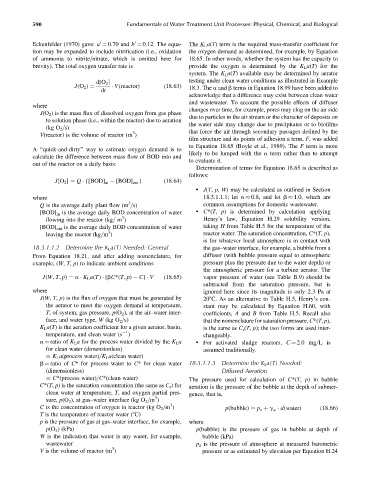Page 635 - Fundamentals of Water Treatment Unit Processes : Physical, Chemical, and Biological
P. 635
590 Fundamentals of Water Treatment Unit Processes: Physical, Chemical, and Biological
Eckenfelder (1970) gave: a ¼ 0.70 and b ¼ 0.12. The equa- The K L a(T) term is the required mass-transfer coefficient for
0
0
tion may be expanded to include nitrification (i.e., oxidation the oxygen demand as determined, for example, by Equation
of ammonia to nitrite=nitrate, which is omitted here for 18.65. In other words, whether the system has the capacity to
brevity). The total oxygen transfer rate is provide the oxygen is determined by the K L a(T) for the
system. The K L a(T) available may be determined by aerator
d[O 2 ] testing under clean water conditions as illustrated in Example
V(reactor) (18:63)
J(O 2 ) ¼ 18.3. The a and b terms in Equation 18.99 have been added to
dt
acknowledge that a difference may exist between clean water
and wastewater. To account the possible effects of diffuser
where
changes over time, for example, pores may clog on the air side
J(O 2 ) is the mass flux of dissolved oxygen from gas phase
due to particles in the air stream or the character of deposits on
to solution phase (i.e., within the reactor) due to aeration
the water side may change due to precipitates or to biofilms
(kg O 2 =s)
3
V(reactor) is the volume of reactor (m ) that force the air through secondary passages defined by the
film structure and its points of adhesion a term, F, was added
to Equation 18.65 (Boyle et al., 1989). The F term is more
A ‘‘quick-and-dirty’’ way to estimate oxygen demand is to
likely to be lumped with the a term rather than to attempt
calculate the difference between mass flow of BOD into and
to evaluate it.
out of the reactor on a daily basis:
Determination of terms for Equation 18.65 is described as
follows:
J[O 2 ] ¼ Q {[BOD] in [BOD] out } (18:64)
. J(T, p, W) may be calculated as outlined in Section
where 18.3.1.1.1; let a 0.8, and let b 1.0, which are
3
Q is the average daily plant flow (m =s) common assumptions for domestic wastewater.
[BOD] in is the average daily BOD concentration of water . C*(T, p) is determined by calculation applying
3
flowing into the reactor (kg= m ) Henry’s law, Equation H.29 solubility version,
[BOD] out is the average daily BOD concentration of water taking H from Table H.5 for the temperature of the
3
leaving the reactor (kg=m ) reactor water. The saturation concentration, C*(T, p),
is for whatever local atmosphere is in contact with
18.3.1.1.2 Determine the K L a(T) Needed: General the gas–water interface, for example, a bubble from a
From Equation 18.21, and after adding nomenclature, for diffuser (with bubble pressure equal to atmospheric
example, (W, T, p) to indicate ambient conditions pressure plus the pressure due to the water depth) or
the atmospheric pressure for a turbine aerator. The
J(W, T, p) ¼ a K L a(T) [bC*(T, p) C] V (18:65) vapor pressure of water (see Table B.9) should be
subtracted from the saturation pressure, but is
where ignored here since its magnitude is only 2.3 Pa at
J(W, T, p) is the flux of oxygen that must be generated by 208C. As an alternative to Table H.5, Henry’s con-
the aerator to meet the oxygen demand at temperature, stant may be calculated by Equation H.60, with
T, of system, gas pressure, p(O 2 ), at the air–water inter- coefficients, A and B from Table H.5. Recall also
face, and water type, W (kg O 2 =s) that the nomenclature for saturation pressure, C*(T, p),
K L a(T) is the aeration coefficient for a given aerator, basin, is the same as C s (T, p); the two forms are used inter-
1
temperature, and clean water (s ) changeably.
a ¼ ratio of K L a for the process water divided by the K L a . For activated sludge reactors, C ¼ 2.0 mg=Lis
for clean water (dimensionless) assumed traditionally.
K L a(process water)=K L a(clean water)
b ¼ ratio of C* for process water to C* for clean water 18.3.1.1.3 Determine the K L a(T) Needed:
(dimensionless) Diffused Aeration
C*(process water)=C*(clean water) The pressure used for calculation of C*(T, p) in bubble
C*(T, p) is the saturation concentration (the same as C s ) for aeration is the pressure of the bubble at the depth of submer-
clean water at temperature, T, and oxygen partial pres- gence, that is,
3
sure, p(O 2 ), at gas–water interface (kg O 2 =m )
3
C is the concentration of oxygen in reactor (kg O 2 =m ) p(bubble) ¼ p a þ g d(water) (18:66)
w
T is the temperature of reactor water (8C)
p is the pressure of gas at gas–water interface, for example, where
p(O 2 ) (kPa) p(bubble) is the pressure of gas in bubble at depth of
W is the indication that water is any water, for example, bubble (kPa)
wastewater p a is the pressure of atmosphere at measured barometric
3
V is the volume of reactor (m ) pressure or as estimated by elevation per Equation H.24

